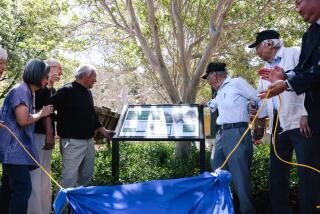Japanese-Americans Mourn an Old Friend
- Share via
Japanese-Americans interned at Manzanar Relocation Center during World War II paid their final respects Tuesday to a long-time friend: Ralph Lazo, the only non-Japanese interned at the camp, who died on New Year’s Day.
“He was my friend for 50 years,” said Mary Kinoshito of Sun Valley, who gathered with about 50 of Lazo’s family members, friends and former co-workers at a graveside service in heavy rain Tuesday at Glen Haven Memorial Park in Kagel Canyon. “I was his neighbor at Manzanar.”
Lazo, who died at 67 of liver disease, went with his Japanese-American friends to the camp in the desolate Owens Valley in 1942.
The War Department had been granted the authority to relocate all people of Japanese, German or Italian ancestry after the bombing of Pearl Harbor by the Japanese on Dec. 7, 1941.
No Germans or Italians were affected. But on the premise there was a threat of a Japanese invasion of the West Coast, the mass evacuation of people of Japanese ancestry was begun in California in March, 1942.
Ten thousand went to Manzanar.
Lazo was stunned, said his sister, Virginia Lazo. She said a classmate at Central Junior High School, near what is now Little Tokyo in downtown Los Angeles, one day asked him, “Ralph, what are you going to do without us? Why don’t you go along?”
“So, he did,” Virginia Lazo said. “He just came in one day and told my dad, ‘I’m going to camp.’ ”
In a 1981 interview, he explained: “These people hadn’t done anything that I hadn’t done except to go to Japanese language school . . . I went down to the old Santa Fe Station and signed on.”
Lazo, of Mexican and Irish descent, didn’t have to lie to government officials about his ancestry. “They didn’t ask,” he said. “Being brown has its advantages.”
To this day, his sister, with whom he shared a home in North Hollywood, and his three children aren’t certain why Lazo volunteered to live at a relocation camp.
“I was never really sure,” said his son, David Lazo, an engineer.
But those who gathered Tuesday to remember Lazo believe they know why.
“He wanted to be with his friends,” Kinoshito said. “He was very loyal.”
“I think he just said, ‘If my friends are going, I’ll go too,” said Sam Mayo, dean of academic affairs at Valley College, who helped Lazo make a video chronicling his experiences at Manzanar. “That’s the way he was.”
Bo Sakaguchi of North Hollywood, another friend from Manzanar, said the Japanese-Americans at the camp didn’t question why Lazo was there. “It was strange to see a Mexican-American among us,” he said.
Government officials discovered Lazo was not a Japanese-American when he was drafted in August, 1944. At that time, a news release from the U. S. Department of the Interior, War Relocation Authority, announced: “America’s only non-Japanese evacuee, Ralph Lazo, . . . of Los Angeles will leave Manzanar Relocation Center soon to join the United States Army.”
In the Army, Lazo served in the South Pacific during the campaign for the liberation of the Philippines. He was awarded a Bronze Star for heroism in combat.
After the war, Lazo graduated from UCLA and earned a master’s degree from Cal State Northridge. He taught at San Fernando Junior High School, Grant and Monroe high schools before becoming a counselor at Valley College in 1970. He stayed at Valley until his retirement in 1987.
Lazo and Mayo also worked together on a project to persuade more Latino parents to encourage their children to get a college education.
But throughout his life, his sister said, Lazo maintained his ties to the Japanese-American community. He was one of 10 contributors who gave $1,000 or more to a fund used to prepare the class-action lawsuit against the U. S. government that won financial compensation for those who were interned.
More to Read
Sign up for Essential California
The most important California stories and recommendations in your inbox every morning.
You may occasionally receive promotional content from the Los Angeles Times.










